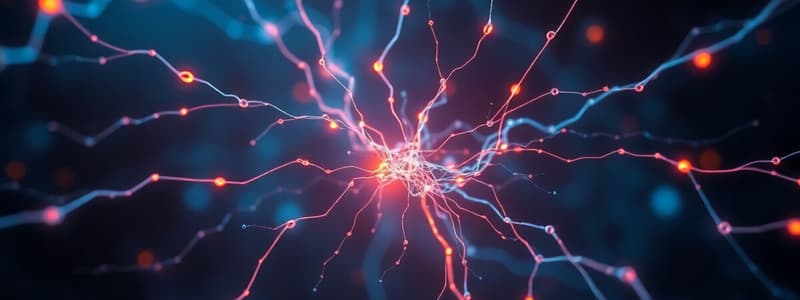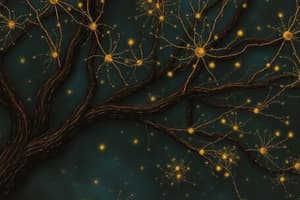Podcast
Questions and Answers
What distinguishes electrical synapses from chemical synapses?
What distinguishes electrical synapses from chemical synapses?
- They consist of at least two neurons.
- They are more common in the central nervous system.
- They allow transmission of potential changes bidirectionally. (correct)
- They are slower in signal transmission.
Which of the following correctly describes the presynaptic neuron?
Which of the following correctly describes the presynaptic neuron?
- Forms a synapse with the axon of the postsynaptic neuron.
- Contains neurotransmitter vesicles in presynaptic knobs. (correct)
- Only transmits impulses away from the synapse.
- Resists fatigue during neurotransmission.
What is the primary role of the postsynaptic neuron?
What is the primary role of the postsynaptic neuron?
- To receive and transmit signals. (correct)
- To release neurotransmitters into the synaptic cleft.
- To form gap junctions with neighboring neurons.
- To initiate action potentials.
What type of synapse is most commonly formed in the nervous system?
What type of synapse is most commonly formed in the nervous system?
Which characteristic does not apply to electrical synapses?
Which characteristic does not apply to electrical synapses?
Why do chemical synapses show fatigue?
Why do chemical synapses show fatigue?
What is the width of the synaptic cleft typically observed?
What is the width of the synaptic cleft typically observed?
Which type of synapse is considered to resist fatigue?
Which type of synapse is considered to resist fatigue?
What triggers the opening of voltage-sensitive Ca2+ channels in the presynaptic neuron?
What triggers the opening of voltage-sensitive Ca2+ channels in the presynaptic neuron?
What is the primary action of neurotransmitters on the postsynaptic membrane?
What is the primary action of neurotransmitters on the postsynaptic membrane?
Which statement accurately describes excitatory postsynaptic potential (EPSP)?
Which statement accurately describes excitatory postsynaptic potential (EPSP)?
What occurs during the release of inhibitory neurotransmitters at the presynaptic terminal?
What occurs during the release of inhibitory neurotransmitters at the presynaptic terminal?
What is one method responsible for the termination of synaptic transmission?
What is one method responsible for the termination of synaptic transmission?
Which factor can contribute to synaptic delay?
Which factor can contribute to synaptic delay?
What is the significance of synaptic delay in neural transmission?
What is the significance of synaptic delay in neural transmission?
In which direction are impulses conducted at synapses?
In which direction are impulses conducted at synapses?
What is the consequence of binding of excitatory neurotransmitters to postsynaptic receptors?
What is the consequence of binding of excitatory neurotransmitters to postsynaptic receptors?
Which mechanism is NOT involved in the termination of synaptic transmission?
Which mechanism is NOT involved in the termination of synaptic transmission?
What causes hyperpolarization in the postsynaptic neuron during inhibitory neurotransmission?
What causes hyperpolarization in the postsynaptic neuron during inhibitory neurotransmission?
What role does synaptic delay play in neuronal communication?
What role does synaptic delay play in neuronal communication?
What initiates the exocytosis of neurotransmitter vesicles in the presynaptic neuron?
What initiates the exocytosis of neurotransmitter vesicles in the presynaptic neuron?
Which factor is least likely to contribute to synaptic delay?
Which factor is least likely to contribute to synaptic delay?
In response to synaptic stimulation, which physiological change occurs specifically during the release of inhibitory neurotransmitters?
In response to synaptic stimulation, which physiological change occurs specifically during the release of inhibitory neurotransmitters?
What is the general duration of synaptic delay observed in neural transmission?
What is the general duration of synaptic delay observed in neural transmission?
What is the primary characteristic that differentiates electrical synapses from chemical synapses?
What is the primary characteristic that differentiates electrical synapses from chemical synapses?
Which type of synapse commonly terminates on the soma of the postsynaptic neuron?
Which type of synapse commonly terminates on the soma of the postsynaptic neuron?
What is transmitted across the synaptic cleft during neurotransmission?
What is transmitted across the synaptic cleft during neurotransmission?
What is a defining feature of presynaptic terminals in chemical synapses?
What is a defining feature of presynaptic terminals in chemical synapses?
What is a common property of chemical synapses related to signal transmission speed?
What is a common property of chemical synapses related to signal transmission speed?
In which part of the nervous system are electrical synapses most commonly found?
In which part of the nervous system are electrical synapses most commonly found?
Which of the following best describes the nature of the synaptic cleft?
Which of the following best describes the nature of the synaptic cleft?
What type of synapse primarily allows for changes in the membrane potential due to the presence of proteins called connexons?
What type of synapse primarily allows for changes in the membrane potential due to the presence of proteins called connexons?
Flashcards
Synapses
Synapses
Areas where neurons connect and communicate.
Electrical Synapses
Electrical Synapses
Rare synapses that directly connect neurons via gap junctions.
Chemical Synapses
Chemical Synapses
Common synapses that use neurotransmitters to transmit signals.
Presynaptic Neuron
Presynaptic Neuron
Signup and view all the flashcards
Postsynaptic Neuron
Postsynaptic Neuron
Signup and view all the flashcards
Synaptic Cleft
Synaptic Cleft
Signup and view all the flashcards
Neurotransmitter Vesicles
Neurotransmitter Vesicles
Signup and view all the flashcards
Axo-dendritic Synapse
Axo-dendritic Synapse
Signup and view all the flashcards
Neurotransmitter Release
Neurotransmitter Release
Signup and view all the flashcards
EPSP
EPSP
Signup and view all the flashcards
IPSP
IPSP
Signup and view all the flashcards
Synaptic Transmission Termination
Synaptic Transmission Termination
Signup and view all the flashcards
Synaptic Delay
Synaptic Delay
Signup and view all the flashcards
One-Way Conduction
One-Way Conduction
Signup and view all the flashcards
Synaptic Delay Importance
Synaptic Delay Importance
Signup and view all the flashcards
Synaptic Delay Causes
Synaptic Delay Causes
Signup and view all the flashcards
Synapse Fatigue
Synapse Fatigue
Signup and view all the flashcards
Presynaptic Knob Function
Presynaptic Knob Function
Signup and view all the flashcards
Postsynaptic Neuron Function
Postsynaptic Neuron Function
Signup and view all the flashcards
Synapse Speed
Synapse Speed
Signup and view all the flashcards
Synapse Direction
Synapse Direction
Signup and view all the flashcards
Synapse Resistance to Fatigue
Synapse Resistance to Fatigue
Signup and view all the flashcards
Ca2+ Role in Neurotransmitter Release
Ca2+ Role in Neurotransmitter Release
Signup and view all the flashcards
Excitatory Postsynaptic Potential (EPSP)
Excitatory Postsynaptic Potential (EPSP)
Signup and view all the flashcards
Inhibitory Postsynaptic Potential (IPSP)
Inhibitory Postsynaptic Potential (IPSP)
Signup and view all the flashcards
How does IPSP hyperpolarize?
How does IPSP hyperpolarize?
Signup and view all the flashcards
One-Way Conduction in Synapses
One-Way Conduction in Synapses
Signup and view all the flashcards
Study Notes
Synapses
- Synapses are areas of contact between neurons.
- Two main types of synapses: Electrical and Chemical.
Electrical Synapses
- Extremely rare.
- Found in the hippocampus and retina.
- Composed of gap junctions (connexons) allowing direct transmission of potential changes between neurons.
- Highly permeable.
- Resist fatigue
- Conduct in both directions
- Faster than chemical synapses.
Chemical Synapses
- Common and prevalent in the CNS.
- Involve at least two neurons.
- Presynaptic neuron releases neurotransmitters.
- Postsynaptic neuron receives the neurotransmitter signal.
- Show fatigue
- Conduct in one direction
- Slower than electrical synapses.
Structure of Chemical Synapses
- Pre-synaptic terminal: Dilated presynaptic knobs containing neurotransmitter vesicles.
- Synaptic cleft: 10-30 nm wide, filled with interstitial fluid. Separates the pre-synaptic and post-synaptic neurons.
- Postsynaptic membrane: Contains receptors for neurotransmitters and then transmits signals to the next neuron.
- Most common types: Axo-dendritic, Axo-somatic, Axo-axonic.
Synaptic Transmission Steps
- Action potential reaches the presynaptic terminal.
- Calcium ion influx.
- Neurotransmitter release via exocytosis (vesicles fuse with membrane to release neurotransmitters into the synaptic cleft).
- Neurotransmitter binds to receptors on the postsynaptic membrane.
- Postsynaptic potential generated.
- Excitatory (EPSP): Depolarizes the postsynaptic membrane.
- Inhibitory (IPSP): Hyperpolarizes the postsynaptic membrane.
- Synaptic transmission termination.
- Active reuptake of neurotransmitters.
- Enzymatic breakdown.
- Diffusion.
Properties of Chemical Synaptic Transmission
- One-way conduction: Transmission only from pre-synaptic to post-synaptic neuron.
- Synaptic delay: ~0.5 msec.
- Synaptic fatigue: Decreased response due to exhaustion of neurotransmitter, receptor inactivation, etc.
Effects of Hypoxia, pH, and Drugs
- Hypoxia: Short-term loss of excitability, and stopping synaptic transmission.
- Alkalosis: Increased excitability.
- Acidosis: Decreased excitability.
- Caffeine/Theophylline: Increase neuronal excitability.
- Strychnine: Causes hyper-excitability of neurons.
- Anesthetics/Hypnotics: Decrease neuronal activity and synaptic transmission.
Studying That Suits You
Use AI to generate personalized quizzes and flashcards to suit your learning preferences.



